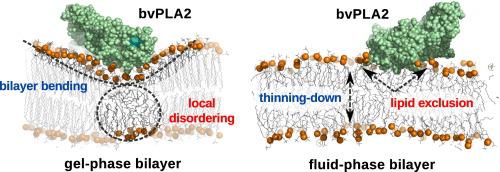Biochimica et Biophysica Acta (BBA) - Biomembranes ( IF 3.4 ) Pub Date : 2020-09-28 , DOI: 10.1016/j.bbamem.2020.183481 Anna S. Alekseeva , Pavel E. Volynsky , Nikolay A. Krylov , Valery P. Chernikov , Elena L. Vodovozova , Ivan A. Boldyrev

|
Phospholipase A2 (PLA2) exerts a wide range of biological effects and attracts a lot of attention of researchers. Two sites are involved in manifestation of PLA2 enzymatic activity: catalytic site responsible for substrate binding and fatty acid cleavage from the sn-2 position of a glycerophospholipid, and interface binding site (IBS) responsible for the protein binding to lipid membrane. IBS is formed by positively charged and hydrophobic amino acids on the outer surface of the protein molecule. Understanding the mechanism of PLA2 interaction with the lipid membrane is the most challenging step in biochemistry of this enzyme. We used a combination of experimental and computer simulation techniques to clarify molecular details of bee venom PLA2 interaction with lipid bilayers formed by palmitoyloleoylphosphatidylcholine or dipalmitoylphosphatidylcholine. We found that after initial enzyme contact with the membrane, a network of hydrogen bonds was formed. This led to deformation of the interacting leaflet and dint formation. The bilayer response to the deformation depended on its phase state. In a gel-phase bilayer, diffusion of lipids is restricted therefore chain melting occurred in both leaflets of the bilayer. In the case of a fluid-phase bilayer, lateral diffusion is possible, and lipid polar head groups were excluded from the contact area. As a result, the bilayer became thinner and a large hydrophobic area was formed. We assume that relative ability of a bilayer to come through lipid redistribution process defines the rate of initial stages of the catalysis.
中文翻译:

磷脂酶A2水解的方式:污点形成,疏水错配和脂质排除
磷脂酶A2(PLA2)具有广泛的生物学作用,引起了研究人员的广泛关注。PLA2酶活性的表现涉及两个位点:催化位点负责底物结合和脂肪酸从sn-2裂解甘油磷脂的位置,以及负责蛋白质与脂质膜结合的界面结合位点(IBS)。IBS由蛋白质分子外表面的带正电荷和疏水性氨基酸形成。了解PLA2与脂质膜相互作用的机制是该酶生物化学中最具挑战性的一步。我们使用实验和计算机模拟技术的组合来阐明蜂毒PLA2与由棕榈酰油酰磷脂酰胆碱或二棕榈酰磷脂酰胆碱形成的脂质双层相互作用的分子细节。我们发现最初的酶与膜接触后,形成了氢键网络。这导致相互作用的小叶变形和斑点形成。双层对变形的响应取决于其相态。在凝胶相双层中,脂质的扩散受到限制,因此在双层的两个小叶中均发生链熔化。在液相双层的情况下,可能发生横向扩散,并且脂质极性头基团被排除在接触区域之外。结果,双层变得更薄并且形成大的疏水区域。我们假设双层通过脂质重新分布过程的相对能力定义了催化初始阶段的速率。


























 京公网安备 11010802027423号
京公网安备 11010802027423号